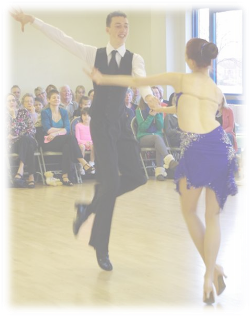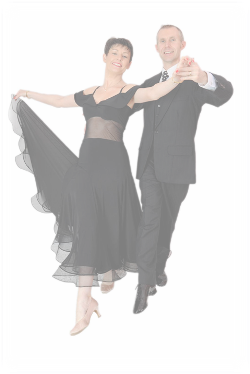|
|
|
Ballroom
|
This can also be called Modern Ballroom or Standard dancing.
Within the Ballroom family of dances are the Waltz, Slow Foxtrot, Tango, Quickstep and Viennese Waltz. These dances are all characterised by a closed hold with your partner, which is retained throughout. Progress is made around the floor in an anti-clockwise direction.
Waltz – probably the most popular of the ballroom dances, characterised by slow rhythmical movements. Popular in 18th century Vienna, it spread across Europe and to England where it was initially thought indecent, therefore it rapidly caught on!
Slow Foxtrot – at its simplest the foxtrot is a series of walks but when developed incorporates turns and lines and is often the favourite of more experienced dancers. History has it that the dance is named after Harry Fox and was then developed to be performed by Fred Astaire and Ginger Rogers. |
 |
Tango – a passionate dance which brings a touch of latin to the ballroom world. It is a serious dance with stop and go movements with slow deliberate steps and then sudden fast movements. Emerging from the ghettos of Argentina it is believed to depict the story of an unwilling woman and a smelly gaucho.
Quickstep – a fun and happy dance with fast movements, which sees couples speeding around the floor even including hops and flicks. The quickstep became popular at the time of the dance bands in the 1920s and incorporates elements of Charleston.
Viennese Waltz – contains few steps and is simpler than the Waltz although it’s faster. It is based on rotation around the floor in soft sweeping movements. This dance attracted the attention of great composers including Johann Strauss.
There is also the Social Foxtrot (Rhythm) which is an easier version of the Slow Foxtrot and danced to the same music as the Slow Foxtrot.
|
Latin American
|
 |
Within this family of dances are the Cha Cha Cha, Samba, Rumba, Paso Doble and Jive.
The latin styles came to popularity after the ballroom dances. Each one has a different origin and character. In these dances the hold can vary and they tend to be more emotionally charged than the elegance of the ballroom dances.
Cha Cha Cha – is a cheeky, fun dance which can be danced to modern music. It is related to the Rumba and is thought to originate from the 1950s as a slowed down form of Mambo.
Samba – a lively feel good party dance depicting the Mardi Gras carnival in Brazil although slightly modified for today’s dance floors. Think of bright colours, lots of hip action and ‘samba bounce’. |
Rumba – is a romantic dance telling the story of seduction between two people. Its origins are back in African tribal dances which made their way to Cuba. A more modern version was then popular in America and Europe.
Paso Doble – the man plays the role of the Spanish Matador and the lady plays the role of his cape portraying the story of the Spanish Bull Fight. It is a dramatic dance with lots of passion. The figures of the Paso Doble were identified by the French and therefore a lot of the terms have French names.
Jive – a light, bright contemporary dance. Incorporating elements of lindy hop, jitterbug, swing and rock & roll. In the Jazz craze of 1920s it was the official youth dance of America. It was brought to Europe in the 1940s and 1950s with the GIs and was further popularised by bands such as Glenn Miller.
|
Sequence Dancing (including Classical Sequence) |
These can be any of the ballroom or latin styles danced in a set 16 bar sequence which is repeated. It also includes Classical Sequence with rhythms such as Saunter, Blues, Two Step, Gavotte, Tango and Waltz. These dances have links to ballet.
Other Dance Styles
Line Dancing – This style of dance was originally danced to Country and Western music in the USA but is now danced to all different styles of music. It’s usually danced individually although there are also some dances for pairs.
Salsa (including Mambo) – Salsa music was a creation which brought a number of different styles of latin music under one simple marketing umbrella. The dance which is performed to this style of music was thought to originate from a Cuban dance called Son which is a forerunner of the Mambo and Cha Cha Cha.
Back to top |
 |
|
|